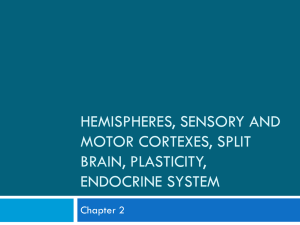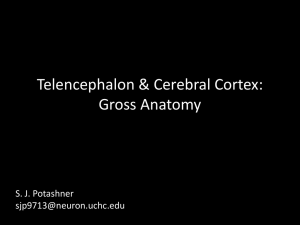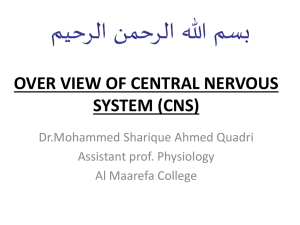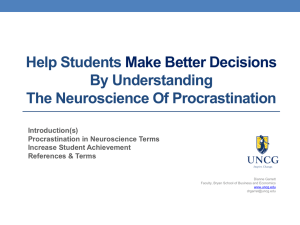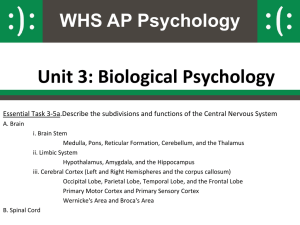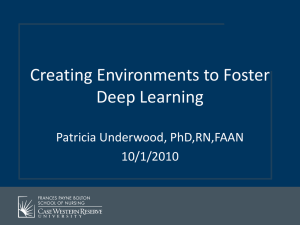Document
advertisement
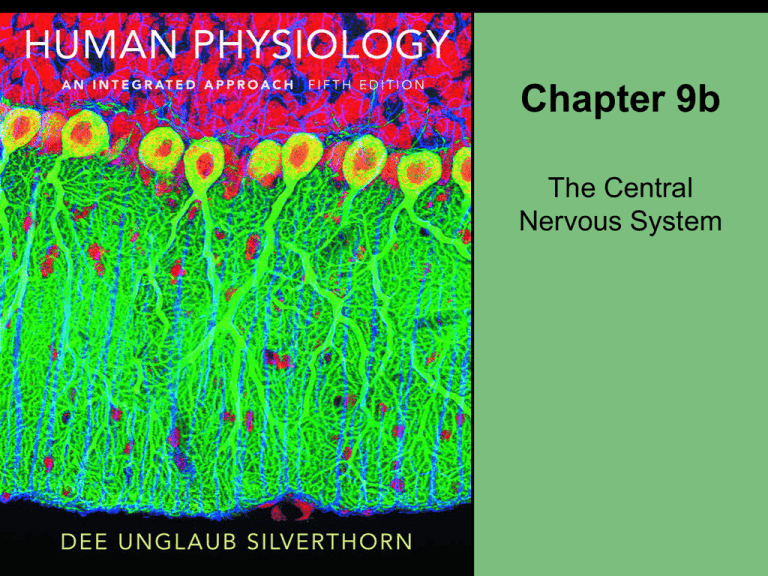
Chapter 9b The Central Nervous System Brain Function: Reflex Pathways in the Brain Sensory input Feedback Sensory system (reflex) Cognitive system (voluntary) Behavioral state system Integration CNS Output Motor system Response Physiological response or behavior (a) A simple neural reflex (b) Behavioral state and cognition influence brain output. Figure 9-14 Brain Function: Cerebral Cortex • From a functional viewpoint, it can be divided into three specializations • Sensory areas • Sensory input translated into perception (awareness) • Motor areas • Direct skeletal muscle movement • Association areas • Integrate information from sensory and motor areas • Can direct voluntary behaviors Brain Function: Functional Areas of the Cerebral Cortex FRONTAL LOBE PARIETAL LOBE Primary somatic sensory cortex Primary motor cortex Skeletal muscle movement Motor association area (premotor cortex) Sensory association area OCCIPITAL LOBE Visual association area Prefrontal association area Vision Visual cortex Taste Gustatory cortex Smell Olfactory cortex Auditory Auditory cortex association area Hearing TEMPORAL LOBE Figure 9-15 Brain Function: Cerebral Lateralization • Each lobe has special functions RIGHT HAND LEFT HAND Prefrontal cortex Prefrontal cortex Speech center C O R P U S Writing Auditory cortex (right ear) Analysis by touch C A L L O S U M General interpretive center (language and mathematical calculation) Auditory cortex (left ear) Spatial visualization and analysis Visual cortex (left visual field) Visual cortex (right visual field) LEFT HEMISPHERE RIGHT HEMISPHERE Figure 9-16 Split Brain Split brain video Brain Function: Sensory Information • Primary somatic sensory cortex • Termination point of pathways from skin, musculoskeletal system, and viscera • Somatosensory pathways • • • • • Touch Temperature Pain Itch Body position Homunculus - Motor and Sensory Brain Function: Sensory Information • Special senses have devoted regions • • • • Visual cortex Auditory cortex Olfactory cortex Gustatory cortex • Processed into perception Brain Function: Motor System • Three major types • Skeletal muscle movement • Somatic motor division • Neuroendocrine signals • Hypothalamus and adrenal medulla • Visceral responses • Autonomic division • Voluntary movement • Primary motor cortex and motor association areas Brain Function: Behavioral State • Modulator of sensory and cognitive processes • Neurons collectively known as diffuse modulatory systems • Originate in reticular formation in brain stem Brain Function: Behavioral State • Four diffuse modulatory systems • • • • Noradrenergic Serotonergic Dopaminergic Cholinergic Brain Function: Behavioral State Table 9-3 Brain Function: PET Scan of the Brain at Work Figure 9-17 Brain Function: Perception Figure 9-18 Brain Function: Diffuse Modulatory Systems Modulate Brain Function To basal nuclei Thalamus Hypothalamus Locus coeruleus (a) Norepinephrine Raphe nuclei Cerebellum (b) Serotonin Figure 9-19a-b Brain Function: Diffuse Modulatory Systems Modulate Brain Function Prefrontal cortex (c) Ventral tegmental area Dopamine Cingulate gyrus To basal nuclei Substantia nigra (d) Fornix Pontine nuclei Acetylcholine Figure 9-19c-d Brain Function: States of Arousal • Electroencephalograms (EEGs) and the sleep cycle • Reticular activating system keeps “conscious brain” awake Figure 9-20a Brain Function: Sleep • Four stages with two major phases • Slow-wave sleep • Adjust body without conscious commands • REM sleep • Brain activity inhibits motor neurons to skeletal muscle, paralyzing them • Dreaming takes place • Circadian rhythm • Suprachiasmatic nucleus Brain Function: Emotion and Motivation • The link between emotions and physiological functions Figure 9-21 Brain Function: Motivation • Defined as internal signals that shape voluntary behavior • Some states known as drives • Work with autonomic and endocrine responses • Motivated behaviors stop • Satiety Brain Function: Moods • Similar to emotions but longer-lasting • Mood disorders • Fourth leading cause of illness worldwide today • Depression • Sleep and appetite disturbances • Alteration of mood and libido • Antidepressant drugs alter synaptic transmission Brain Function: Learning and Memory • Learning has two broad types • Associative • Nonassociative • Habituation • Sensitization • Memory has several types • Short-term and long-term • Reflexive and declarative Brain Function: Memory Processing Figure 9-22 Brain Function: Long-Term Memory Table 9-4 Brain Function: Language • Cerebral processing of spoken and visual language • Damage to Wernicke’s causes receptive aphasia Motor cortex Broca’s area Wernicke’s area Read words Visual cortex (a) Speaking a written word Figure 9-23a Brain Function: Language • Damage to Broca’s area causes expressive aphasia Motor cortex Broca’s area Hear words Auditory Wernicke’s cortex area (b) Speaking a heard word Figure 9-23b Brain Function: Personality • Combination of experience and inheritance • Schizophrenia • Both genetic and environmental basis Summary • Emergent properties • Evolution of CNS • Anatomy of CNS • Neural tube, gray and white matter, tracts, meninges, and cranium • Choroid plexus, CSF, and blood-brain barrier • Spinal cord • Spinal nerves, dorsal root, dorsal root ganglia, ventral roots, ascending tracts, descending tracts, propriospinal tracts, and spinal reflexes Summary: Brain • Brain stem, cranial nerves, reticular formation, medulla oblongata, somatosensory tract, corticospinal tract, and pyramid • Pons, midbrain, cerebellum, diencephalon, thalamus, hypothalamus, pituitary gland, pineal gland, and corpus callosum • Frontal, parietal, temporal, and occipital lobes • Cerebral cortex, basal ganglia, limbic system, amygdala, cingulate gyrus, and hippocampus Summary: Brain Function • Sensory system, cognitive system, and behavioral state system • Sensory areas, motor areas, association areas, and cerebral lateralization • Primary somatic sensory cortex, visual cortex, auditory cortex, gustatory cortex, and olfactory cortex • Association areas and perception Summary: Brain Function (continued) • Primary motor cortex, motor association area, behavioral state system, diffuse modulatory systems, and reticular activating system • Circadian rhythms, sleep, motivation, and moods • Learning, habituation, memory, and consolidation

